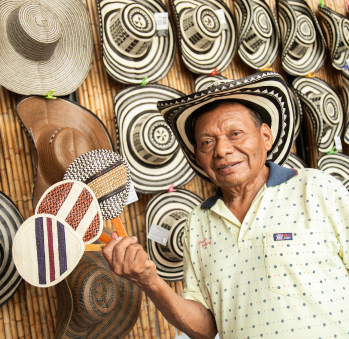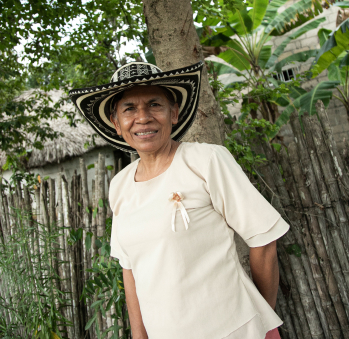Heriberto Chávez
Workshop: Artesanos Palma De Seje
Craft: Cestería
Trail: Cordoba Route
Location: Ayapel, Córdoba
For Heriberto, the sun holds cardinal importance. He understands that it’s nature who dictates the course of events, not us mortal humans. The sunlight, with its heat and intensity, determines the color of the fibers from the Ayapel’s palma de seje. There’s no other way. Now in his thirties, this craftsman from Córdoba lives by this principle as his motto. He cares for and cherishes this raw material that put his town on the cultural map of the country. The fact that people recognize that Ayapel, within the jurisdiction of El Cedro, hosts the growth of this palm of natty eyes fills him with pride. This palm, native to this geographical point in Colombia, is good for weaving baskets, lamps, and whatever else one can imagine. It has not only given him a sense of purpose but has also bestowed his community of craftspeople with a reason to thrive.
Though his weaving craft didn’t come from tradition, he aspires to establish it as such. He recalls being fond of the arts since childhood; he excelled in drawing and painting. With happiness, he recalls the time he fashioned birds out of totumo seeds. “”Art was a gift from God,”” he states joyfully. His inclination towards handiwork was so evident that when an announcement seeking volunteers for a crafts workshop circulated in his town, a neighbor told him it was meant for him. He hesitated, suspecting that the list of participants was already finalized, and thus didn’t attend. Fate, however, had other plans; they called him, and he embraced the opportunity. He was fortunate in that an instant connection formed between him and his fellow classmates. They became not just his closest friends but also his colleagues.
His workshop is a familial one, as he’s passed on his passion for palma de seje weaving. His elder and younger brothers assisted him in bending metal rods and weaving, while his parents took charge of drying the raw material. All of them immersed themselves in this craft that gains more admirers with each passing day. But his journey doesn’t stop there. He also provides employment to other members of his community—his sister-in-law, his cousin and her husband and sister, as well as three other material providers, whom he regards as part of his extended family.
They’ve all learned to work with the palm, distinguishing it from other fibers such as coconut or mil peso. The distinction lies in its tiny perforations and the caramel and chocolate hues of its branches. Herein lies the importance of the sun: it dictates the drying process and the final color of the palm. It can either acquire its distinct hue or, conversely, darken excessively due to excessive humidity and go to waste. Much time has passed since he embarked on his learning journey. In the beginning, he struggled to complete a piece in seje palm, often having to undo his weaving two or more times until it reached the level of refinement it shows today. He’s slightly embarrassed to admit that once, out of frustration, he even kicked a tray because he couldn’t complete it satisfactorily. He also confesses that, like many of his fellow weavers who would shed tears when their results didn’t meet expectations, he experienced the same emotions on numerous occasions. In retrospect, he’s grateful for the reprimands and the insistence on perfection, as they propelled him to where he stands today. He learned the virtues of patience and persistence.
He began participating in artisanal fairs in 2015, starting with Expoartesano. Despite mastering the craft, he recognizes that the knowledge is infinite, and the craft itself guides the path. It’s all about deciphering nature’s cues and heeding its advice.
Craft










Artisans along the way
Artisans along the way
No puede copiar contenido de esta página




























































